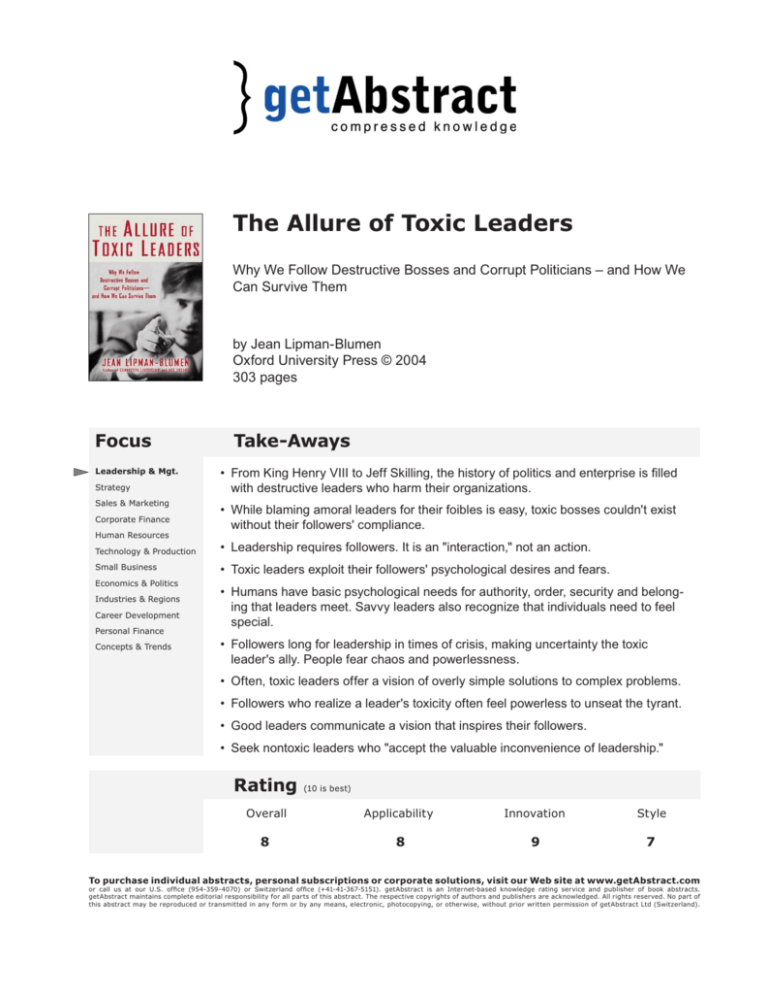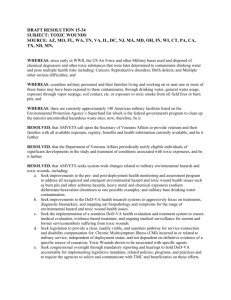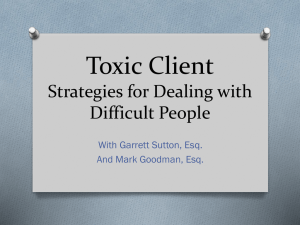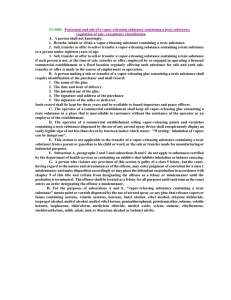
The Allure of Toxic Leaders
Why We Follow Destructive Bosses and Corrupt Politicians – and How We
Can Survive Them
by Jean Lipman-Blumen
Oxford University Press © 2004
303 pages
Focus
Leadership & Mgt.
Strategy
Sales & Marketing
Corporate Finance
Take-Aways
• From King Henry VIII to Jeff Skilling, the history of politics and enterprise is filled
with destructive leaders who harm their organizations.
• While blaming amoral leaders for their foibles is easy, toxic bosses couldn't exist
without their followers' compliance.
Human Resources
Technology & Production
• Leadership requires followers. It is an "interaction," not an action.
Small Business
• Toxic leaders exploit their followers' psychological desires and fears.
Economics & Politics
Industries & Regions
Career Development
Personal Finance
Concepts & Trends
• Humans have basic psychological needs for authority, order, security and belonging that leaders meet. Savvy leaders also recognize that individuals need to feel
special.
• Followers long for leadership in times of crisis, making uncertainty the toxic
leader's ally. People fear chaos and powerlessness.
• Often, toxic leaders offer a vision of overly simple solutions to complex problems.
• Followers who realize a leader's toxicity often feel powerless to unseat the tyrant.
• Good leaders communicate a vision that inspires their followers.
• Seek nontoxic leaders who "accept the valuable inconvenience of leadership."
Rating
(10 is best)
Overall
Applicability
Innovation
Style
8
8
9
7
To purchase individual abstracts, personal subscriptions or corporate solutions, visit our Web site at www.getAbstract.com
or call us at our U.S. office (954-359-4070) or Switzerland office (+41-41-367-5151). getAbstract is an Internet-based knowledge rating service and publisher of book abstracts.
getAbstract maintains complete editorial responsibility for all parts of this abstract. The respective copyrights of authors and publishers are acknowledged. All rights reserved. No part of
this abstract may be reproduced or transmitted in any form or by any means, electronic, photocopying, or otherwise, without prior written permission of getAbstract Ltd (Switzerland).
Relevance
What You Will Learn
In this Abstract, you will learn: 1) What makes a leader toxic; 2) Why followers shoulder
much of the blame for toxic leaders; 3) What psychologically motivates followers; and
4) How to shed toxic leaders and recruit nontoxic leaders.
Recommendation
This intriguing, intellectual study of disastrous leadership offers a courageous
interpretation of corporate scandal and political folly. Amoral leaders are not entirely
to blame, Jean Lipman-Blumen argues. Rather, followers enable misguided leaders
to rise to power and stay there. Her analysis applies psychological principles to Adolf
Hitler’s Germany and Jeff Skilling’s Enron (not exactly parallel, but you get the idea)
and concludes that toxic leaders’ followers are willing victims who allowed misguided
bosses to appeal to their basest instincts. While Lipman-Blumen’s assertions are startling,
she makes a compelling case written in dense but readable prose with intriguing detail.
getAbstract.com suggests this book to anyone seeking a deeper understanding of the
relationship between leaders and their followers, particularly given the swath cut by
today’s toxic leaders.
Abstract
“Leadership is
often treated as
an action by the
leader directed
toward or against
others. More
appropriately,
we should view
leadership as
an interaction
between leaders
and their
followers.”
“We commonly
accept toxic
leaders because
we fear that we
are incapable of
overthrowing such
strong figures all
by ourselves.”
What Makes Destructive Leaders So Strong?
From Adolf Hitler to Enron’s Jeff Skilling, from China’s Chairman Mao to Sunbeam’s Al
Dunlap, the history of politics and enterprise is filled with toxic leaders. These destructive,
power-hungry people make poor decisions meant to aggrandize themselves and demean
others. They seek to control those around them, who gladly give the boss credit, accept
some for themselves and resolutely deny blame. Toxic leaders enjoy moments of glory
but finally fail, leaving their organizations in tatters and solidifying their ignominious
places in history.
Recent decades have seen a plethora of these ruthless, skilled bosses, in part because
wallflowers, do-gooders and saints rarely seek positions of political or corporate
leadership. After all, such traits as humility and selflessness are of little help as one
climbs the corporate ladder. By their very nature, and often to the betterment of their
performance, leaders are driven and competitive, charismatic and self-confident, smart
and cunning. But those characteristics also can push a leader’s behavior into the realm
of toxicity.
The corporate scandals of the past few years offer a laundry list of toxic leaders.
Tyco’s Dennis Kozlowski, WorldCom’s Bernard Ebbers, ImClone’s Sam Waksal, and
HealthSouth’s Richard Scrushy went from corporate heroes to accused criminals in
only a few short years. Business and politics are not the only realms that produce toxic
leaders. For years toxic leaders ran the Catholic Church and failed to address a rash of
pedophilia by priests.
Blaming these leaders for their faults is easy. Conventional wisdom says these executives
were amoral men who made poor decisions. But in actuality, a more realistic, if troubling,
force is at work. Followers enable and abet toxic leaders. In fact, people often prefer toxic
The Allure of Toxic Leaders
© Copyright 2005 getAbstract
2 of 5
“Illusions are the
umbilical cord
linking leaders and
followers. Leaders
understand their
followers’ need
for illusions.”
leaders. Human nature propels people toward leaders who offer grand visions and strong
leadership. Too often, historians define leadership as something imposed by the leader
upon the masses. The true story is more complex: Leadership is a relationship between the
leader and his followers. Hitler could carry out his plan to exterminate Jews and dominate
the world only with the help of millions of German voters, workers and soldiers.
Soon after the conviction of Michael Milken – the 1980s junk bond king who was
convicted of criminal fraud – a number of his former employees appeared on a TV show
to defend him. Even though his criminal acts ultimately cost them their jobs, Milken’s
minions were unswayed by the prosecutor’s arguments or the jury’s verdict.
Defining the toxic leader is tricky. Even leaders who are remembered as near saints,
such as Abraham Lincoln, Franklin Roosevelt and Mother Theresa, sometimes behaved
immorally or made bad decisions. Yet, to be a truly toxic leader, one must consistently
exhibit toxic traits and routinely engage in dysfunctional behavior. Those traits and
behavior patterns include:
“Most humans
long to be part of
something pure
and beautiful, or at
least seemingly so
despite a festering
malignancy.”
“Members of the
entourage derive
their status and
raison d’être from
their relationship
to the leader. So
they are always
dedicated to
keeping their
leader in power.”
“Leaders serve
many purposes
for their followers.
If they didn’t, we
wouldn’t yearn for
them, seek them
out, or even create
them when they
don’t exist.”
• Lack of integrity and honesty. Lying to followers to bolster a powerful vision.
• Outsized ambition that puts the leader's quest for glory above the well being of
others.
• Egotism and arrogance that foster incompetence and corruption.
• Actions that "intimidate, demoralize, demean and marginalize" others.
• Breaching opponents' and followers' basic human rights, and stifling criticism.
• Holding tight to power by undermining potential successors.
Of course, toxic leaders never admit that these ugly descriptions apply to them. At last
check, Ebbers, Kozlowski and Skilling maintained their innocence and were shocked that
anyone would question their motives. And as Milken’s ex-employees proved, followers
can remain convinced of their leader’s merit, despite strong opposing evidence.
Exploiting Followers’ Psychological Needs
Usually, toxic leaders are not psychologists, yet they tend to possess an uncanny ability
to tap into their followers’ deep-seated psychological motivations. Toxic leaders typically
exploit four basic needs and two primal fears:
• The need for authority – As children, we relied heavily on our parents to meet our
basic needs for food, clothing and shelter, and to teach us society’s values and norms
through a system of rewards and punishments. Children quickly learn obedience, and
while teens rebel against parental authority, that rebellion follows its own strict rules.
Teen rebellion often takes the form of spiked hair, baggy pants or other fashions
dictated by the peer group, which becomes the new authority figure. So the pattern
of obedience established in early childhood stays with us.
• The need for security – Those teen rebels with the green hair and pierced eyebrows
long for freedom from parental authority, yet they also have a deep-seated need
for security. When young adults finally separate from their families, they find
that freedom comes with a price. The security of the family structure is gone, and
people seek replacements for parental authority, often finding leaders who promise
security. In practice, this means people gladly trade freedom for security. After the
September 11, 2001, terror attacks, for instance, Americans traded the freedom of
hassle-free travel for the security of baggage searches and long delays at airport Xray machines.
The Allure of Toxic Leaders
© Copyright 2005 getAbstract
3 of 5
“Amid contrapuntal
certainties and
uncertainties,
we seek out
leaders to help
us negotiate the
dangers we meet.”
“Shaken by
fearsome
conditions, we
transform fallible
human leaders
into infallible
gods – gods for
whose protection
and guidance we
would willingly
exchange our
freedom, as the
Germans did
in the decades
following World
War I.”
“Crises, after
all, are not just
threatening
and terrifying
situations. Crises
are fires for
which we have
no firefighters,
invasions against
which we have no
defenses, plagues
for which we have
no medicines.”
“Leaders and
the media find
themselves in a
delicate, no-touch
tango of mutual
need. One wants
adulatory coverage; the other
wants full access
or, better yet, a
major scoop.”
• The need to feel special – People have a special weakness for leaders who make
them feel like part of a chosen group. Milken’s Drexel Burnham was considered
the coolest place to work in the 1980s, while Enron was the trendy employer of the
1990s. The energy trader inculcated its employees with the feeling that they were
special members of an elite club of the world’s smartest, hardest-working people.
Even the swanky headquarters in Houston told Enron employees they were special.
They must be part of a chosen few if the parking lot was filled with BMWs and if
they were treated to massages, gourmet coffee and upscale lunches in the company
cafeteria. Status melds with meaning to create a strong psychological motivation.
• The need to belong – Even as individuals want to feel special, they also have a
deep need to be part of a group or community. Humans are social animals who
find happiness and meaning in the approval of others. So Enron’s employees were
comforted by assurances from Chairman Ken Lay and CEO Jeff Skilling that the
company’s shares would continue to rise. And German citizens found security and
meaning under Hitler, even as his leadership was disastrous for their nation.
• The fear of ostracism – The fear of social death is a powerful motivator for humans
who innately want to belong. Thus, it is unusual for followers to speak out against the
toxic leader’s lies or poor decisions. Doing so would result in being excluded from
the group. Toxic leaders demand more fealty than benign leaders require, and they
do not tolerate dissent or questions about their decisions. This psychological pressure
makes it especially difficult for whistle-blowers, those few brave company insiders
who alert leaders and outside authorities about problems within a company.
• The fear of powerlessness – It seems odd that so many bad leaders manage to stay in
power so long, but most followers feel powerless to unseat a leader. Moreover, because
toxic leaders stifle dissent, employees often do not know how their co-workers truly
feel about a leader. Often workers quit in disgust about a boss’s actions, only to learn
later that others had the same concerns but were afraid to speak out.
Pitching the Toxic Vision
To truly rule, a toxic leader must understand more than his followers’ primal psychological
desires and fears. He also must know that they crave illusions, and he must deliver a
vision that exploits this need. The vision must captivate the follower and fulfill the quest
to belong to something grand and beautiful. Enron claimed to have finally mastered a
business model that could be applied profitably to any industry. Only later did everyone
learn that its visions were misguided. Toxic leaders often offer easy remedies to complex
problems, while benign leaders are unlikely to rely all that much on their personal visions.
In fact, benign leaders often place the burden of solving problems on their followers
– making a toxic leader an easier choice.
If a leader articulates an inspiring vision, followers are all too eager to go along. In times
of crisis, it’s especially easy for followers to assign greatness to mere mortals. After
Germany’s humiliating WWI defeat, the struggling nation was especially vulnerable to
Hitler, a charismatic leader who vowed to return his country to greatness. Germans saw
authoritarianism as a worthwhile trade for new security.
Crisis also gave toxic leader Al Dunlap his position as CEO of Sunbeam Corp., a maker
of small appliances. The firm routinely missed profit goals. It hired Dunlap, who crowed
about his past successes in an autobiography, although those glories were later debunked.
In the worst toxic leader mode, Dunlap was arrogant and rude. He began at Sunbeam by
screaming at its assembled executives for hours. The company ultimately disintegrated
into bankruptcy.
The Allure of Toxic Leaders
© Copyright 2005 getAbstract
4 of 5
“Autonomy
and freedom
liberate us from
dependency on
tyrants as well as
on authoritarian
and incompetent
leaders. Freedom
and autonomy,
frequently braced
by recognized
anxiety, give the
courage to act,
even in the face
of death.”
People are very susceptible at times of crisis. After the Sept. 11 terror attacks, New York
Mayor Rudolph Giuliani ascended to the status of near infallibility as he reassured New
Yorkers that they would be safe. Thanks to his masterful performance, the crisis elevated
the mayor from a mere mortal into a political star who could remind Americans of their
long-hidden patriotism and their newfound willingness to sacrifice. Giuliani remained a
benign leader rather than a toxic one, yet the rise of his status during those difficult days
shows just how fervently followers seek leaders in times of uncertainty and chaos. The
need for leadership is so strong people always seek new leaders or create them where
none exist.
Given the strong need for leaders, followers who are confronted with toxic leaders
unsurprisingly find excuses to tolerate them. Employees submit to bad bosses because
they want their paychecks or are afraid to be left jobless. People think they incur a
personal risk if they confront a toxic leader, due to their need for order or their fear that
a new boss could be worse.
Toxic leaders often surround themselves with entourages, people whose power comes
from their relationship with the leader and who, therefore, are loyal to the leader rather
than to some external measure of right and wrong. The members of the entourage are
close assistants who take the blame for the boss’s mistakes, but give him all the credit for
successes. In some cases, where other employees band together to succeed in spite of a
bad boss, working under a toxic leader can deepen collegial relationships and make the
organization stronger.
Dismissing and Replacing Toxic Leaders
Five strategies can help followers move away from a toxic leader and do better in the
future:
“It is then that we
reach our true
heroic potential.
Our yearning for
self-esteem is
satiated. We are
calling forth the
leader within.”
• "Matriculating in the school of anxiety" – Confront the fear and worry of challenging
a toxic leader. Exercising courage will make you stronger.
• "Seeking the leader within and strengthening democratic institutions" – Become
independent. Use democracy to foster good leaders and vote out bad ones.
• "Demanding leaders who disillusion us" – Toxic leaders spread false comfort through
their visions. Instead, embrace reality and live up to the demands of authenticity.
• "Kicking the vision habit and the we/they dichotomy" – Be willing to strive without
being reassured that you are extra special and that a happy ending is in sight.
• "Drafting the next generation of leaders" – See leadership as a duty, not a privilege.
The best way to repel toxic leaders is to recruit nontoxic leaders. Urge more humble,
fair-minded potential leaders to step forward and “accept the valuable inconvenience of
leadership.” Assuming authority can inspire new leaders to be considerate and selfless,
to identify with others’ feelings, to develop as individuals, to find “coherence” amid
confusion and to become self-governing. In other words, nontoxic leaders achieve and
bestow freedom instead of spreading poison.
About The Author
Jean Lipman-Blumen is a professor of public policy and organizational behavior at
Claremont Graduate University in California. She is a co-founding director of the
Institute for Advanced Studies and served as a special adviser to President Jimmy Carter.
Her previous books include The Competitive Edge and Hot Groups.
The Allure of Toxic Leaders
© Copyright 2005 getAbstract
5 of 5








